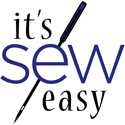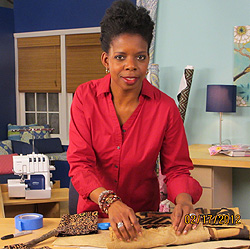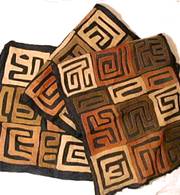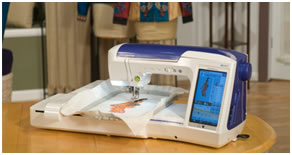 |
www.itsseweasytv.com |
| 311-1 | Print | Close [X] |
| Lisa Shepard Stewart shows the special consideration and techniques that are required to utilize hand-woven fabrics professionally. Watch the video for this project online at: |
For More Information Visit: www.brothersews.com |
It's Sew Easy Segment – KUBA WALL HANGING (Working with Handwovens)
Skills: 1. Handling & tips for working with handwovens 2. Designing with fusible appliqué, cut free-hand and secured with edge-stitching 3. Finishing the appliqué project as a simple wall hanging
Intro: Working with Handwoven Fabrics Handwovens as a category open up a literal world of possibilities, with exciting choices to fit any décor. Most, like kuba raffia cloth from Central Africa, are made of locally produced natural fibers. Finding hand-loomed fabrics has become easier because of overall trends in cross-cultural design, allowing a decorator of any skill level to add her own creativity by stitching, cutting, fusing or embellishing to quickly multiply the creative options. To assure success, keep these tips in mind for working with handwovens:
Project: Kuba Appliqué Wall Hanging Kuba cloth has had a worldwide influence on art and design, as evidenced by some of the works of Matisse, Picasso, Klee and others. The unique look and labor-intensive technique makes it a highly valued piece in the collections of many art & textile collectors. Now creative sewers can enjoy a similar look with easy-to-find materials. This simplified version of the technique involves the use of linen or burlap (also called jute). These fabrics have a coarse look and feel that approaches that of real raffia cloth. You can further embellish your project with scraps of leather, suede, mudcloth, couched yarns & cordings and interesting found objects! YOU’LL NEED: -- Jute fabric for background (large enough for your intended project) 1. Apply fusible web to the appliqué fabrics according to the web manufacturer’s directions. Remove paper backing. 2. Cut a few practice shapes from the appliqué fabrics. The shapes are simple to cut free-hand. Arrange them as desired on a practice piece of the background fabric, and fuse appliqué shapes into place. Try a few variations, laying out and fusing appliqués to test scraps of background fabric, experimenting with a variety of stitch selections, including a basic blanket stitch or other decorative stitches. Try a slight zigzag stitch to add a bit more depth to the stitching. Double needle stitching will also heighten the effect, as will some of the decorative stitches. Save these samples for reference as you begin the actual project. 3. Arrange and fuse appliqués into place as you did for the practice pieces. Remember to leave a border area free of appliqués along the edges for your seam allowances, well hanging casings, or other finishing details. Stitch around all raw edges of the appliqué shapes, guided by the results of your test pieces. 4. Finish the raw edges of the appliqué block according to the end use. Turn under all edges plus a top casing for a wall hanging, sew on a backing and insert a pillow form, or stitch the block to the front of a canvas tote bag.
Alternate project: Pillow ------------------------------------------------------------------------------------------------------------------------------------------------------ Lisa Shepard Stewart is an author, designer and instructor based in New Jersey. In her how-to project books, Lisa encourages others to express themselves creatively through culturally relevant techniques and materials. She promotes her work through workshops, trunk shows and special events both in the US and internationally. Visit www.CulturedExpressions.com, call 1-866-MUDCLOTH, or write PO Box 356, Rahway, NJ 07065 ©2003-2012 Cultured Expressions, Inc. All Rights Reserved. May not be reproduced in whole or part by any means including, but not limited to mechanical, electronic, or digital means, without express consent from Cultured ExpressioFeatured sewing machine in this segment: Sewing Machine Featured in this Segment:
|
Host: Lisa Shepard |
| Copyright © 2015 It's Sew Easy. All Rights Reserved. |

